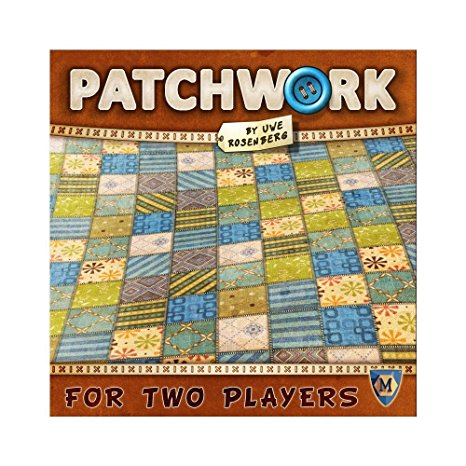Patchwork is now an art form where quilts are created from beautiful uneven pieces of fabric. In the Patchwork board game players work to balance time and buttons (currency) to purchase patches and place them strategically on their quilt. The aim of the game is to create a quilt with the most patch spaces covered. Players need to select their pieces carefully, work to keep a healthy supply of buttons and consider the placement of their pieces, all before time runs out. This unique game is created for 2 players and typically lasts less than 30 minutes. This game is a great way to develop number fluency and spatial awareness.
Game Instructions:

Both players begin with a quilt board, a time token, and 5 buttons. Place the tokens on the starting space of the time board. The player who last used a needle begins. Place the patches in a circle around the board. Find the smallest patchand place the neutral token in front of this patch in a clockwise order. Keep the 7×7 special tile to the side. Place the special (one square) patches on the marked spaces of the time board.

The player whose token is furthest behind always takes their turn next. If both tokens are on one space, the token on top goes first. On your turn, one option is to advance your token one space ahead of your opponent’s token.
For each space you move, you receive one button. The second option is to choose a patch from the three patches in front of the neutral token (in clockwise order). You will then move the neutral token next to the chosen patch. You must pay for your patch with the number of buttons depicted on it. After you can place your patch on your board anywhere, as long as it does not overlap another patch. Finally, you move your token the number of time spaces on the label of your patch.

On the time board every time you pass or land on a single patch you immediately pick it up and place it on your quilt board. Every time you pass a button on the board you will receive the same amount of buttons as the number of patch spaces covered by your quilt. The first player to completely fill a 7×7 square on their quilt receives the special tile, which is worth 7 points.
Curriculum Connections
Coming soon.
Connections to Processes
Mental Math and estimation [ME]: Although mental math in this game is a smaller role, students are developing their skills as they continuously attempt to gain the most points by adding up the amount of squares covered and subtracting the empty spaces, doubled.
Problem Solving [PS]: In this game students must use various strategies to understand what is the most effective way to cover their board, leaving the least amount of empty squares. In addition to this, students must make decisions regarding the importance of time and currency, i.e. whether or not they should buy a piece that is worth more buttons but also costs more time. Through assessing their opponents’ strategies and trying multiple strategies of their own, students gain an understanding of effective approaches and they gain confidence in a willingness to explore a variety of solutions.
Reasoning [R]: During this game, students must use logic to decide what to buy based on: the area covered, the fit of the shape in the current quilt, the cost in buttons, and the cost in time. Students must be able to defend to other players why they selected a certain piece and the general strategy they believe is the most effective. Students also have the opportunity to listen to their opponent’s reasoning.
Visualization [V]: Patchwork helps students develop spatial sense as they move from physically manipulating quilt pieces (using translations, rotations, and reflections) in various positions on the board, towards being able to visualize how potential pieces would be able to fit on their quilt; this skill will help students’ decide which piece is most advantageous to them. Another aspect of visualization in this game is the quilt board itself, as students gain experience covering a large square (9×9) with square units of equal size.
